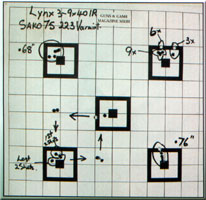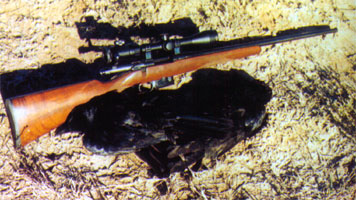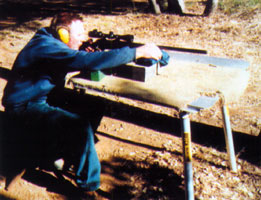

3-9x40 IR Scope
By Andy Montgomery. Guns and Game, October-December 2002.
One of Lynx's Professional Monotube series scope, the 3-9x40IR enters the realm of being a "general purpose" scope with the addition of an illuminated reticle. This scope has a fast-focus ocular lens which has a protective rubber ring on the eyepiece, and a very generous, easy to grip, power change ring. The battery/switch turret is situated midway between the power ring and the focus ring and is centred on top of the ocular housing. The illuminated reticle is green in colour.
The 3-9x40IR has a 1" tube with plenty of length for mounting on any action. The windage and elevation turrets are slightly larger than a couple of the other Lynx scopes I have, and I assume this is to accommodate the new easy grip "T", or wing adjusting knobs. The adjustments are quite stiff with 0.7cm/lOom (1/4" at 100 yards) clicks. This is a good feature, as it assures the scope, once adjusted, will stay put.
The objective has a standard 40mm lens, factory adjusted for parallax at 100 metres. As with all other Lynx scopes tested, parallax was as close to perfect as it's possible to get and this scope exhibited almost zero parallax at all ranges. The exterior finish is standard matte black, and is very durable. It is also non-reflective which is useful on a hunting scope.
This scope is quite heavy for a 3-9 at 490 grams, compared with 374 grams for a standard 3-9x42, and would therefore not be recommended for use on a heavy recoiling rifle from .300 Weatherby up. The eye relief ranges from 99mm (3 7/8") on 3x, to 83mm (3 1/4") on 9x. While on the subject of eye relief, it is important to remember when adjusting the scope on your rifle for eye relief to set the scope on minimum power while you're adjusting it, or a sore eyebrow may result. This is more of a problem with ultra light rifles down as far as 7mm-08, 6.5x55, etc. There is nothing more upsetting than a bump in the face, which results in instant recoil shyness and lots of misses, and maybe a ruined hunting trip.
For initial testing, the 3-9x40IR was mounted on a CZ527 Prestige .223. This rifle is a real gem and is seeing a lot of use in professional shooting, making it the logical choice. During initial sighting in I noticed the field of view to be quite a bit smaller than I am used to. Field of view measured 34 feet at 100 yards on 3x and 12.5 feet at 100 yards on 9x. As I leave sighting in and testing till late in the day, around 4pm, when any winds have dropped off to a minimum, I noticed that as the light started to fade, the scope's perceived brightness seemed to drop off. These minor problems are definitely part of the trade off with extras (like the illuminated reticle) in modern scopes. To achieve the illuminated reticle, there are two extra lenses, one with the heavy sidebars and one with the fine illuminated centre cross. Two extra pieces of glass means less transmitted light. The reduction in field of view is in the same trade-off basket, the extra bits have to go somewhere inside and thus light and field of view suffer. For these reasons I feel that illuminated reticles have a specialized sphere of use, and perhaps, because of the above-mentioned compromises, some shooters may find they are sacrificing standard scope performance for an illuminated reticle.
The scope's performance on the target was consistent, and although I only fired 3-shot groups to get the scope zeroed, all groups were right up there with the best this rifle has achieved. When it came to the power change test, windage and elevation test, and a couple of 5-shot groups, the scope was mounted on a heavy Sako 75 in .223. This rifle has a better small group record than the very light CZ. Experience has show that no matter how well a light rifle will shoot, when it comes to continued consistency on the bench, there is no substitute for plenty of weight. The scope performed very well in all tests, with the only thing noted that on 3x the point of aim moved approximately 15mm.

All field-testing was carried out on the CZ 527, as I much prefer the light rifle in both my professional shooting truck, as well as for hunting. I went down to our "rabbits in the wattle" patch and the Lynx performed very well, with the only misses being attributed to shooter error. Rabbits were taken out to around 180 metres with absolute ease with a steady rest. For walk-about hunting, right up until the sun actually set, which is the real test, and for the last half hour of useable light, the illuminated reticle came into its own. As the centre cross in this scope is very fine, it would be easily lost on a rabbit in the lengthening shadows of late afternoon without the illumination. I did find the illuminated reticle was only clear on the number-one setting, to my eye, settings 2, and 3 particularly, became fuzzy and I found it covered up the aiming mark. I also used the 3-9x40IR for a few nights professional shooting with 100% success. The second night the reticle became very dull (towards 2am), as the battery was almost flat.
I had forgotten to turn the scope off after the first night of shooting until 7am the next morning, which was about 12 hours run time. The battery is a 2032 button-type and they are readily available at chemists and news agencies. The cost ranges from $3 to $6. The service life seems to be about 18-20 hours of continuous use. These batteries have a relatively long shelf life so you could store a spare for the next hunting trip.
In conclusion, if you know you need an illuminated reticle scope; then this Lynx model's consistent performance will provide what you're looking for.
 |
Two crows shot with the lynx 3-9x40IR and CZ527 .223. They were taken at 160m. This scope is good for varmints with its fine reticle. |
| The author testing the Lynx 3-9x40IR at the bench. |  |